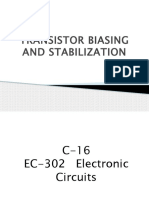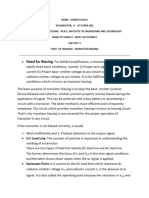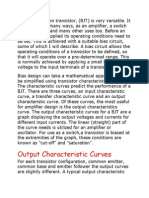DC Biasing
Uploaded by
nagarajDC Biasing
Uploaded by
nagarajDC BiasingBJTs
1 INTRODUCTION The dc level of operation of a transistor affect the ac response, and vice versa. The dc level is controlled by a number of factors, including the range of possible operating points on the device characteristics. For the BJT amplifier, Once the desired dc current and voltage levels have been defined, a network must be constructed that will establish the desired operating pointa number of these networks are analyzed in this chapter. Each design will also determine the stability of the system, that is, how sensitive the system is to temperature variations In most instances the base current IB is the first quantity to be determined. Once IB is known, the relationships of Eqs. (1) through (3) can be applied to find the remaining quantities of interest.
2 OPERATING POINT The term biasing is an all-inclusive term for the application of dc voltages to establish a fixed level of current and voltage. For transistor amplifiers the resulting dc current and voltage establish an operating point on the characteristics that define the region that will be employed for amplification of the applied signal. Since the operating point is a fixed point on the characteristics, it is also called the quiescent point (abbreviated Q-point). By definition, quiescent means quiet, still, inactive. Figure 4.1 shows a general output device characteristic with four operating points indicated.
The biasing circuit can be designed to set the device operation at any of these points or others within the active region. The maximum ratings are indicated on the characteristics of Fig. 1 by a horizontal line for the maximum collector current Ic_max and a vertical line at the maximum collector-to-emitter voltage VCE-max. The maximum power constraint is defined by the curve PCmax in the same figure. At the lower end of the scales are the cutoff region, defined by IB =<0 V, and the saturation region, defined by VCE =<VCEsat. The BJT device could be biased to operate outside these maximum limits, but the result of such operation would be either a considerable shortening of the lifetime of the device or destruction of the device. Confining ourselves to the active region, one can select many different operating areas or points. If no bias were used, the device would initially be completely off, resulting in a Q-point at Anamely, zero current through the device (and zero voltage across it).Since it is necessary to bias a device so that it can respond to the entire range of an input signal, point A would not be suitable. For point B, if a signal is applied to the circuit, the device will vary in current and voltage from operating point, allowing the device to react to (and possibly amplify) both the positive and negative excursions of the input signal. If the input signal is properly chosen, the voltage and current of the device will vary but not enough to drive the device into cutoff or saturation. Point C would allow some positive and negative variation of the output signal, but the peak to- peak value would be limited by the proximity of VCE =0V,IC = 0 mA. Operating at point C also raises some concern about the nonlinearities introduced by the fact that the spacing between IB curves is rapidly changing in this region.
In general, it is preferable to operate where the gain of the device is fairly constant (or linear) to ensure that the amplification over the entire swing of input signal is the same. Point B is a region of more linear spacing and therefore more linear operation, as shown in Fig. 1. Point D sets the device operating point near the maximum voltage and power level. The output voltage swing in the positive direction is thus limited if the maximum voltage is not to be exceeded. Point B therefore seems the best operating point in terms of linear gain and largest possible voltage and current swing. This is usually the desired condition for small-signal amplifiers we will be concentrating primarily on biasing the transistor for small-signal amplification operation. One other very important biasing factor must be considered. Having selected and biased the BJT at a desired operating point, the effect of temperature must also be taken into account. Temperature causes the device parameters such as the transistor current gain (ac) and the transistor leakage current (ICEO) to change. Higher temperatures result in increased leakage currents in the device, thereby changing the operating condition set by the biasing network. The result is that the network design must also provide a degree of temperature stability so that temperature changes result in minimum changes in the operating point. This maintenance of the operating point can be specified by a stability factor, S, which indicates the degree of change in operating point due to a temperature variation. For the BJT to be biased in its linear or active operating region the following must be true: 1. The baseemitter junction must be forward-biased (p-region voltage more positive), with a resulting forward-bias voltage of about 0.6 to 0.7 V. 2. The basecollector junction must be reverse-biased (n-region more positive), with the reverse-bias voltage being any value within the maximum limits of the device. [Note that for forward bias the voltage across the p-n junction is ppositive, while for reverse bias it is opposite (reverse) with npositive. This emphasis on the initial letter should provide a means of helping memorize the necessary voltage polarity.] Operation in the cutoff, saturation, and linear regions of the BJT characteristic are 1. Linear-region operation: Baseemitter junction forward biased Basecollector junction reverse biased 2. Cutoff-region operation: Baseemitter junction reverse biased 3. Saturation-region operation: Baseemitter junction forward biased
Basecollector junction forward biased FIXED-BIAS CIRCUIT The fixed-bias circuit is given in Fig.2. Even though the network employs an npn transistor, the equations and calculations apply equally well to a pnp transistor configuration merely by changing all current directions and voltage polarities. For the dc analysis the network can be isolated from the indicated ac levels by replacing the capacitors with an open circuit equivalent. In addition, the dc supply VCC can be separated into two supplies (for analysis purposes only) as shown in Fig. 3 to permit a separation of input and output circuits.
Forward Bias of BaseEmitter Consider first the baseemitter circuit loop of Fig.3 Writing Kirchhoffs voltage equation in the clockwise direction for the loop, we obtain VCC- IBRB _ VBE = 0 Note the polarity of the voltage drop across RB as established by the indicated direction of IB. Solving the equation for the current IB will result in the following: IB = VCC VBE RB 1 From Equation (1) the base current is the current through RB and by Ohms law that current is the voltage across RB divided by the resistance RB. The voltage across RB is the applied voltage VCC at one end less the drop across the base-to-emitter junction (VBE). since the supply voltage VCC and the baseemitter voltage VBE are constants, the selection of a base resistor, RB, sets the level of base current for the operating point. CollectorEmitter Loop The collectoremitter section of the network appears in Fig.5 with the indicated direction of current IC and the resulting polarity across RC. The magnitude of the collector current is related directly to IB through It is interesting to note that since the base current is controlled by the level of RB and IC is related to IB by a constant , the magnitude
of IC is not a function of the resistance RC. Change RC to any level and it will not affect the level of IB or IC as long as we remain in the active region of the device. However, as we shall see, the level of RC will determine the magnitude of VCE, which is an important parameter. Applying Kirchhoffs voltage law in the clockwise direction around the indicated closed loop of Fig..5 will result in the following:
which states in words that the voltage across the collectoremitter region of a transistor in the fixed-bias configuration is the supply voltage less the drop across RC. VCE = VC - VE Where VCE is the voltage from collector to emitter and VC and VE are the voltages from collector and emitter to ground respectively. But in this case, since VE = 0 V, we have
since and VE =0 V, then
Transistor Saturation The term saturation is applied to any system where levels have reached their maximum values. For the fixed-bias configuration of Fig. the short circuit has been applied, causing the voltage across RC to be the applied voltage VCC. The resulting saturation current for the fixed-bias configuration is
Determine the following for the fixed-bias configuration of Fig. 4.7. (a) IBQ and ICQ. (b) VCEQ. (c) VB and VC. (d) VBC.
Load-Line Analysis The analysis thus far has been performed using a level of corresponding with the resulting Q-point. We will now investigate how the network parameters define the possible range of Q-points and how the actual Q-point is determined.
The network of Fig. 1a establishes an output equation that relates the variables IC and VCE in the following manner: VCE =VCC - ICRC (2 ) The output characteristics of the transistor also relate the same two variables IC and VCE as shown in Fig. 1b. The device characteristics of IC versus VCE are provided in Fig. 1b. We must now superimpose the straight line defined by Eq. (2) on the characteristics. The straight line is defined by two points. If we choose IC to be 0 mA, we are specifying the horizontal axis as the line on which one point is located. By substituting IC = 0 mA into Eq. (2), we find that VCE = VCC - (0)RC and VCE = VCC |IC=0 mA (3) Defining one point for the straight line as shown in Fig. 2.
If we now choose VCE to be 0 V, which establishes the vertical axis as the line on which the second point will be defined, we find that IC is determined by the following equation: 0 = VCC - ICRC And IC=VCC/RC |VCE = 0 V (4) Joining the two points defined by Eqs. (3) and (4), the straight line established by Eq. (2) can be drawn. The resulting line on the characteristic curve is called the load line since it is defined by the load resistor RC. By solving for the resulting level of IB, the actual Qpoint can be established as shown in Fig. 2 If the level of IB is changed by varying the value of RB the Q-point moves up or down the load line as shown in Fig. 3. If VCC is held fixed and RC changed, the load line will shift as shown in Fig. 4. If IB is held fixed, the Q-point will move as shown in the same figure. If RC is fixed and VCC varied, the load line shifts as shown in Fig. 5.
Example
You might also like
- 2021-Jack W Baker-Seismic Hazard and Risk AnalysisNo ratings yet2021-Jack W Baker-Seismic Hazard and Risk Analysis595 pages
- Fin 200 Time Value of Money Tutorial 2 Solutions 2021.100% (2)Fin 200 Time Value of Money Tutorial 2 Solutions 2021.2 pages
- Limits of Operation:-: Versus V For A Range of Values of INo ratings yetLimits of Operation:-: Versus V For A Range of Values of I18 pages
- Unit Ibiasing of Discrete BJT and MosfetNo ratings yetUnit Ibiasing of Discrete BJT and Mosfet57 pages
- Biasing: Unit - Ii Transistor Biasing Circuits Ans Small Signal Analysis of BJT Amplifiers 9 HrsNo ratings yetBiasing: Unit - Ii Transistor Biasing Circuits Ans Small Signal Analysis of BJT Amplifiers 9 Hrs19 pages
- Transistor Biasing and Stabilization: Lesson - 1100% (1)Transistor Biasing and Stabilization: Lesson - 157 pages
- Lab#7: Study of Common Emitter Transistor Amplifier Circuit100% (2)Lab#7: Study of Common Emitter Transistor Amplifier Circuit6 pages
- The Common Emitter Amplifier Circuit: Bipolar TransistorNo ratings yetThe Common Emitter Amplifier Circuit: Bipolar Transistor10 pages
- DC Biasing Emitter Stabilized - Voltage Divider 30112020 054503pmNo ratings yetDC Biasing Emitter Stabilized - Voltage Divider 30112020 054503pm19 pages
- Reference Guide To Useful Electronic Circuits And Circuit Design Techniques - Part 1From EverandReference Guide To Useful Electronic Circuits And Circuit Design Techniques - Part 12.5/5 (3)
- Reference Guide To Useful Electronic Circuits And Circuit Design Techniques - Part 2From EverandReference Guide To Useful Electronic Circuits And Circuit Design Techniques - Part 2No ratings yet
- Digital Image Processing Chapter3 Nagaraja N SNo ratings yetDigital Image Processing Chapter3 Nagaraja N S18 pages
- Data Converters: Analog Versus Discrete Time SignalsNo ratings yetData Converters: Analog Versus Discrete Time Signals5 pages
- Fine Roller Mill Alpha Ii: Type ALPHA II: The Standard of Hydraulic High-Performance Roller Mills, For Roller GapsNo ratings yetFine Roller Mill Alpha Ii: Type ALPHA II: The Standard of Hydraulic High-Performance Roller Mills, For Roller Gaps8 pages
- Bidirectional power flow in an electric vehicle using predictive control algorithm including sneak circuit analysisNo ratings yetBidirectional power flow in an electric vehicle using predictive control algorithm including sneak circuit analysis12 pages
- Rajasthan Board Class 12 Physics Ss 40 1 2018No ratings yetRajasthan Board Class 12 Physics Ss 40 1 20188 pages
- Y7 Autumn Block 5 WO1 Represent Tenths and Hundredths As Diagrams 2019No ratings yetY7 Autumn Block 5 WO1 Represent Tenths and Hundredths As Diagrams 20192 pages
- Chapter-Ix - Introduction To Soil Reinforcement TechniqueNo ratings yetChapter-Ix - Introduction To Soil Reinforcement Technique33 pages
- Test Scenarios of Youtube: Practical No. 1No ratings yetTest Scenarios of Youtube: Practical No. 184 pages
- Over Head Transmission Line Fault Detection100% (1)Over Head Transmission Line Fault Detection9 pages
- Infrastructure As A Service (Iaas) : A Comparative Performance Analysis of Open-Source Cloud PlatformsNo ratings yetInfrastructure As A Service (Iaas) : A Comparative Performance Analysis of Open-Source Cloud Platforms6 pages
- L3 - Representing Instructions in The ComputerNo ratings yetL3 - Representing Instructions in The Computer13 pages
- Plate Load Test Din 18134 Ev1ev2 Lab FormNo ratings yetPlate Load Test Din 18134 Ev1ev2 Lab Form1 page
- 2021-Jack W Baker-Seismic Hazard and Risk Analysis2021-Jack W Baker-Seismic Hazard and Risk Analysis
- Fin 200 Time Value of Money Tutorial 2 Solutions 2021.Fin 200 Time Value of Money Tutorial 2 Solutions 2021.
- Limits of Operation:-: Versus V For A Range of Values of ILimits of Operation:-: Versus V For A Range of Values of I
- Biasing: Unit - Ii Transistor Biasing Circuits Ans Small Signal Analysis of BJT Amplifiers 9 HrsBiasing: Unit - Ii Transistor Biasing Circuits Ans Small Signal Analysis of BJT Amplifiers 9 Hrs
- Lab#7: Study of Common Emitter Transistor Amplifier CircuitLab#7: Study of Common Emitter Transistor Amplifier Circuit
- The Common Emitter Amplifier Circuit: Bipolar TransistorThe Common Emitter Amplifier Circuit: Bipolar Transistor
- DC Biasing Emitter Stabilized - Voltage Divider 30112020 054503pmDC Biasing Emitter Stabilized - Voltage Divider 30112020 054503pm
- Reference Guide To Useful Electronic Circuits And Circuit Design Techniques - Part 1From EverandReference Guide To Useful Electronic Circuits And Circuit Design Techniques - Part 1
- Reference Guide To Useful Electronic Circuits And Circuit Design Techniques - Part 2From EverandReference Guide To Useful Electronic Circuits And Circuit Design Techniques - Part 2
- Data Converters: Analog Versus Discrete Time SignalsData Converters: Analog Versus Discrete Time Signals
- Fine Roller Mill Alpha Ii: Type ALPHA II: The Standard of Hydraulic High-Performance Roller Mills, For Roller GapsFine Roller Mill Alpha Ii: Type ALPHA II: The Standard of Hydraulic High-Performance Roller Mills, For Roller Gaps
- Bidirectional power flow in an electric vehicle using predictive control algorithm including sneak circuit analysisBidirectional power flow in an electric vehicle using predictive control algorithm including sneak circuit analysis
- Y7 Autumn Block 5 WO1 Represent Tenths and Hundredths As Diagrams 2019Y7 Autumn Block 5 WO1 Represent Tenths and Hundredths As Diagrams 2019
- Chapter-Ix - Introduction To Soil Reinforcement TechniqueChapter-Ix - Introduction To Soil Reinforcement Technique
- Infrastructure As A Service (Iaas) : A Comparative Performance Analysis of Open-Source Cloud PlatformsInfrastructure As A Service (Iaas) : A Comparative Performance Analysis of Open-Source Cloud Platforms

































































































